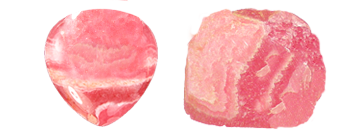 Photo of Rhodochrosite in Processed & Rough Form
Photo of Rhodochrosite in Processed & Rough Form
Rhodochrosite is a mineral with a hardness of 4 out of 10 on the Mohs scale of mineral hardness [?]. These Trigonally structured gems are made of manganese carbonate, their full chemical compound being MnCO3.
Rhodocrosite is a manganese carbonate, a mineral of the calcite series with a hexagonal crystal system. It is isomorphous with calcite and siderite.
It occurs as semitransparent, rhombohedral crystals with poor luster, frequently saddle-shaped, growing into druses, or as concretionary masses, sometimes with irregular, contorted veining. It has low hardness and perfect rhombohedral cleavage.
Normally a definite pink, it can be faded pink or slightly orange. Raspberry red is the most common color. The color rises with the increasing of iron. Brown and yellow colors are caused by calcium and manganese.
Chemical alteration turns it blackish or slightly brownish. When exposed to air, it becomes covered with a dark film through oxidation of manganese. It is infusible, insoluble in cold hydrochloric acid, (unlike pink calcite), but becomes soluble when heated (unlike rhodonite).
The massive material is characterized by a bright pink color, generally in distinct bands (as with agate and malachite), which may be curved or slightly contorted, with narrow pale pink or whitish veining. The aggregates are light-dark stripes with the layers very notched.
It has a color similar to that of rhodonite, but is distinguished by its concretionary structure and by the fact that it is visibly attacked by hydrochloric acid. It is also much less hard.
Rhodocrosite is found in medium-temperature hydrothermal veins associated with copper, silver, and lead sulfides and other manganese minerals. It is much rarer in pegmatites. It is fairly common as a sedimentary mineral in the oxidation zone of sulfide deposits or as a precipitate from hydrothermal solutions. It is stable with rhodonite, tephroite and manganese oxides under a wide range of metamorphic conditions, with complete dissociation in the amphibolite facies.
Splendid rhombohedral crystals measuring up to 5cm (2 in) on edge are found in many localities in Colorado (USA) and in silver-bearing veins in Transylvania (Romania) and Freiberg (Germany) and in groups of perfect blood-red scalenohedra near Hotazel (South Africa). There are sizable crystals at Butte, Montana (USA), Huelva (Spain), Ariege (France) and Chiatura (Russia). It occurs together with braunite and bixbyite in Kalahari Desert, Cape Province, and South Africa.
Radiate concretionary aggregates, often with fine color banding, come from Catamarca (Argentina), Magdalena (Sonora, Mexico), Kapnik (Romania), and various places in Germany. In Italy, it is found at St. Marcel (Val d'Aosta), Ulzio (Piedmont), Val Malenco (Sondrio), Elba (Livorno), in the Gambatesa deposit (Sestri Levante) and associated with manganese oxides on the island of San Pietro (Sardinia).
It can be confused with rhodonite.
In the gem trade and market, the banded variety of rhodocrosite is known as Inca rose or rosinca. It is also called dialogite, bacon strip stone, raspberry spar, manganese spar, capillitite, ponite, carbonate of manganese, manganosiderite.
The specific gravity [?] for Rhodochrosite is 3.6, it's refractive index [?] is 1.60-1.80, and it's double refraction [?] is 0.22.
History
Rhodocrosite derives its name from the Greek "rhodon," meaning "pink" or "rose red." It has, on occasion, been called inca-rose because of the location of the main deposits. It has formed as stalagmites in the silver mines of the Incas since they were abandoned in the 13th century.
Industrial Usages
Rhodocrosite is used as an ore of manganese when available in large enough masses.
Despite its rather low hardness, rhodocrosite is used as an ornamental material because of its pleasing color. Concretionary masses are polished and used.
Small slabs are used for mosaics, boxes, pots, and figurines, but the mineral is somewhat brittle. It is also made into necklace beads or other types of jewelry. Quite large and almost transparent crystals have yielded attractive, curved gems. It is considered a semiprecious gem, faceted, or cut cabochon. It is also of interest to scientists and collectors.
Rhodocrosite has a somewhat low value. Necklaces of transparent pieces are worth more, although the gem's relative lack of hardness can make it lose its polish easily. It is neither imitated nor produced synthetically.





